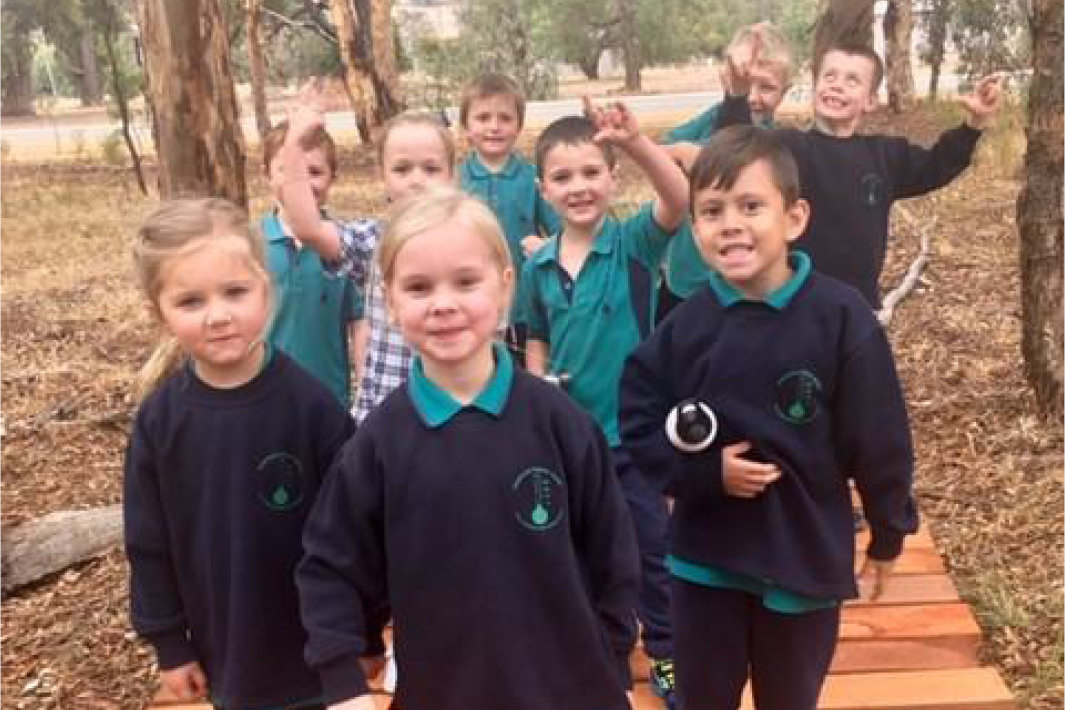CASE STUDY

Age Groups: 0-7 | 7-13
Grant Name:
School: Wandering Primary School
Grant Sponsor:
Wandering Primary School is located about 120kms south of Perth in WA’s wheat belt region. The school has 10 acres of land with over 50 percent being bushland. In this bushland area, they had created a natural habitat for local insects and animals like the Monitor Lizard, as well as fenced off an area to support the breeding area of Black Cockatoos.
The school’s vision was to turn the bushland into a space featuring a nature trail with spots of interest that students could use daily for learning science and for other school curriculum. A key aspect of the project was to encourage the students to have ownership of the outdoor classroom through helping to create and maintain it.
Being located on the school playground, students could make cubbies in it and use it for play as well as learning.
A key goal of the project was to protect the existing native flora and further enhance it with indigenous local plants.
Eager to implement their project, in 2018, the school applied for, and was successful in receiving a $4,300 South32 Junior Landcare Enhancing Habitats Grant for their Nature Trail Project.
Project Implementation
The students planted local species of trees and plants that support and encourage the population of local birds and animals. They also built nesting boxes for Phascogale, also known as wambengers, a small Australian marsupial. The local Lions Club supported the project through installing a bridge and built a bench for the children to sit on.
Environmental Outcomes
The planting of native flora by the children, teachers and volunteers has helped provide a refuge habitat for local fauna including echidna, a monitor , several Black Cockatoos, Baudins, Carnabys, and redtails. The school also has an abundance of blue wrens, red-capped parrots, honey eaters, and scarlet robins. The work done is also helping to control the bridal creeper on the school grounds, considered one of the worst weeds in Australia. The nesting boxes the children built will help maintain the local Phascogale population.
Educational Outcomes
The children helped select the plants as well as every week assisted the teacher and school gardener with planting, clearing, and weeding. They increased their knowledge about the local species of fauna and about how to build nesting boxes. The students gained a sense of ownership of the natural environment around their school. The students’ engagement in the curriculum areas included sustainability, design and technologies as well as personal, social and community health
Community/Social Outcomes
There was great community and stakeholder engagement across the project. Fifty community members volunteered their time to help support the project, including the local Lions Club as mentioned above. The local CWA (Country Women’s Association) helped with the planting, the local carpenter built the old principals house, the Wandering Shire Council helped to move unwanted tree logs from the school grounds and the Department of Education stepped in to help remove non-native plants.
Conclusion
Jennifer Dunn, the school principal and Nature Trail Project manager, said, “The project’s overarching goal was to care for our land, educate the students to care for it and encourage the animals to take up residency. I think we have achieved this.”
Another teacher involved said, "The planting was a great experience in working with the Lion’s Club having different generations working together. I think it will be wonderful as the children are going to be able to come back to the school and see what they created from scratch. "
One of the students involved in the project said, “The plants are making the place look very good and the nesting boxes that we put up will help lots of animals."
 Teachers & Educators
Teachers & Educators Youth or Community Groups
Youth or Community Groups